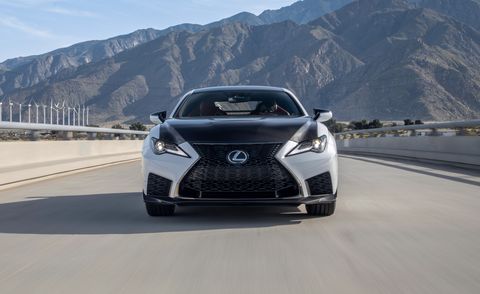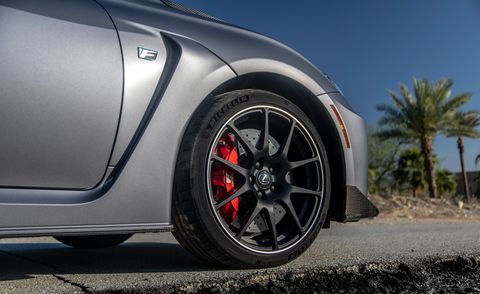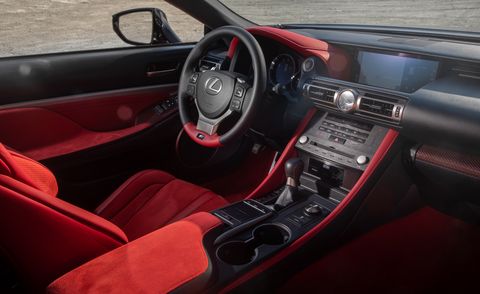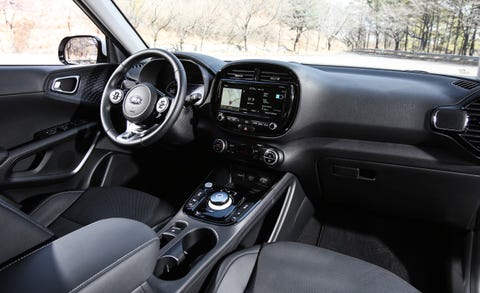We have a total of nine minutes in the Lexus's new 2020 RC F Track Edition. Nine. It's not much, we'll admit. And it's certainly not enough to level a final verdict on this special model, only 50 of which will come to the United States. But it's enough to say with certainty that chief engineer Yuuichi Tsurumoto, a man with a plan, hit his target with the low-volume coupe. He wanted a car that could be controlled with the throttle. Specifically, the goal was to build a car that can be steered with the throttle. And Tsurumoto, well, he has succeeded. The 2020 RC F Track Edition speaks the language of chunked rubber and gray smoke. It paints its character in broad, black swaths at corner exit and speaks its mind through titanium mufflers. It is a driver's car in the way that only a Japanese luxury coupe can be—sharp and loud when that's what you want, yet still mighty opulent.
So, no, getting behind the wheel of this becarboned lightweight version of the RC F coupe isn't going to squeeze every last drop of adrenaline from your system. There's still a lot of Lexus here. It's not, despite what its name implies, a no-compromise track car like a 911 GT3 RS or the late, great Camaro Z28. But it will tingle your frontal lobe in many of the same ways.
More Power, Barely
The base RC F is revised for 2020, becoming slightly lighter and more powerful. The 5.0-liter V-8 under every 2020 RC F's hood gains five horsepower, for a total of 472, over that of the previous model. The same Aisin eight-speed automatic directs torque to the rear axle, where, in the Track Edition, it's shuttled to the tarmac via an aggressively tuned Torsen limited-slip differential. Standard RC F models are available with an optional torque-vectoring differential, but Tsurumoto-san preferred the directness of the gear-type differential in the Track Edition. And he's right. We drove the standard RC F equipped with the torque-vectoring differential, and its corner-exit personality was far more benign. Dancing on the edge of grip and exiting tail out onto every straight, the Track Edition is a slice of throttle-steering heaven.
Strangely, Michelin Pilot Sport 4S tires—255/35R-19s at the front and 275/35R-19s at the rear—are fitted to both versions of the RC F. It is an odd track car indeed that uses the same tires as its less exclusive brethren, a choice Tsurumoto defends by pointing out that the Track Edition must remain a fully streetable Lexus at heart. Perhaps Street Edition would be a more fitting name.
Final-drive gearing is changed in both versions—from 2.97:1 to 3.13:1—an adjustment that permits a more linear throttle calibration without sacrificing response. Lexus says its new launch-control system, which we didn't get to try, will help reduce the RC F's zero-to-60 time to 4.2 seconds while the Track Edition will drop to 4.0 seconds. The last RC F we tested required 4.3 seconds to hit that milestone.
Weight Shaver
Standard carbon-ceramic brakes on the Track Edition contribute to its being a claimed 121 pounds lighter than the 2020 RC F, which itself loses—so says Lexus—55 pounds over the 2019 model thanks to a variety of weight-saving measures, including tweaked suspension components, hollow half-shafts, a lightened intake manifold, and other bits. Forged 19-inch BBS wheels are standard and further contribute to the reduction in unsprung weight. The modest weight loss still leaves the Track Edition, at a claimed 3781 pounds, about 165 pounds heavier than a BMW M4, though still more than 300 pounds lighter than the last Mercedes-AMG C63 S coupe we tested.
Track Edition models get a carbon-fiber hood, roof, and rear wing that Lexus claims will yield 58 pounds of downforce at 168 mph. And the front splitter, a precisely shaped thing sprouting canards off either side, uses a rubber spoiler attached to its underside to further smooth airflow beneath the car. Both models use the same springs, but the Track Edition offers more aggressively tuned adaptive dampers, which help shape its more dramatic personality on the track.
Lexus will ask $65,775 for the standard 2020 RC F and $97,675 for the Track Edition, both of which will be at dealers before summer. That means the cost of the Track Edition's lightweighting amounts to a not insubstantial $261 per pound, which will seem mighty expensive until you carry that first fully committed slide right to the track's edge.


















